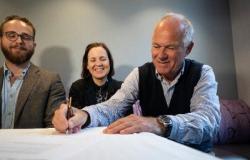Expensive electricity, jumps in inflation and a slowdown in growth: Norway has handled it all better than Sweden, believes a former Swedish finance minister.
Right now
While Norway’s economy has in recent years struggled with high inflation and signs of slowing growth recently, the picture on the other side of the border is far more demanding.
Sweden’s GDP development is among the EU’s weakest, unemployment is over 8 per cent and the real wage development the real wage development Real wages are the wages you earn, but adjusted for price increases. If prices rise more as a percentage than wages, real wages are lower. has been weak.
– Norway has leveled out growth in a completely different way, even though it is weaker in Norway as well. Unemployment has been high in Sweden, and is now almost twice as high as Norway, says Mikael Damberg, former finance minister in Sweden.
E24 meets Damberg, who is now in the opposition as fiscal spokesperson for the Social Democrats, and Prime Minister Jonas Gahr Støre (Ap) at Kulturhuset in Oslo. They both gave speeches at the annual Bratteli seminar organized by the Labor Party this week.
Read on E24+
Have earned several hundred thousand by “flipping” old cabins
– Be passive
Sweden recently recorded the worst bankruptcy month in 30 years, while unemployment is at a whopping 8.5 percent and the latest inflation figure came in at 5.4 percent for January.
Støre points out that Norway and Sweden have always exchanged experience and benefited greatly from it.
– It has been an important goal for the government to manage through the period of high price growth without a large increase in unemployment. If we had high unemployment in addition to high interest rates and price growth, the situation would be even more demanding, says the Prime Minister.
The government in Sweden has since autumn 2022 been a coalition government led by Ulf Kristersson from the conservative party Moderaterna. Before that, there were social democratic governments led by Stefan Löfven and Magdalena Andersson.
The former Swedish finance minister believes that the Norwegian state has been far more active than the Swedish state in recent years.
– The Swedish government has been passive, and just let the central bank do the work, says Damberg.
– Sweden’s Labor Minister Johan Pehrson has indicated that unemployment is due to high immigration and poor integration. Is that also a factor?
– If you look at the groups who are long-term unemployed, there are people who lack schooling, who cannot speak the language very well or have a disability. These groups are far from the labor market. You have to be active, and demands must be placed on them, says Damberg.
This is not the first time the opposition in Sweden has accused the current government of being passive, which the prime minister himself has rejected on several occasions.
Refers to measures
Damberg highlights several measures here at home that he believes have helped Norway:
- An electricity subsidy that came much faster compared to in Sweden.
– In Sweden, inflation had already eaten into the economy when the electricity subsidy came, says Damberg.
- According to him, Norway reacted to hold back the price increases on food.
– In Sweden, we have not had such an active government, and we have had higher price increases for food, he says.
- Active support for those who have been hit hardest by the cost crisis, such as pensioners, families with children and poor single people.
– In Sweden, for example, child support has not been touched during the entire crisis, says Damberg.
- More labor market measures.
Støre acknowledges that Norway has the Oil Fund, but points out that the fund does not determine Norwegian budgets.
– There are political priorities we have to make, says the Prime Minister.
– Vocational participation explains a lot
Statistics Norway economist Olav Slettebø says it is difficult to compare the Norwegian economy with the Swedish one, partly because of Norway’s large petroleum sector and the extraordinary prices of oil and gas.
He also points out that Sweden has a particularly high occupational participation occupational participationThe labor force participation rate is the proportion of the population that takes part in the labor market, either as employed or looking for a job. .
– It is significantly higher in Sweden than the average in Europe and also higher than in Norway. This is not only due to the Swedes’ good work ethic, but also major institutional differences between countries, says Slettebø.
While Sweden’s unemployment rate is 3–4 percentage points higher than Norway’s, labor force participation is 3–4 percentage points higher, according to the OECD.
– High labor force participation is an important explanation for the relatively high unemployment in Sweden, which is not a new phenomenon, says Slettebø.
The proportion of employed people in Norway and Sweden, on the other hand, is quite similar. For institutional reasons, more unemployed people are registered as unemployed in Sweden than in Norway, according to Slettebø.
– Seen against this background, it does not seem plausible that labor market measures or electricity subsidies are the main explanation for the unemployment difference between Norway and Sweden in 2024, says the economist.
Nevertheless, he agrees that the electricity subsidy in Norway was a good move by the Norwegian government.
– It has helped to keep price inflation down, and has transferred purchasing power from public administration to households in an unusual time, says Slettebø.
– More sensible interaction
Sweden’s key interest rate was negative for five years, before it was lowered to 0 percent in 2020.
Olav Slettebø in Statistics Norway believes that Damberg has a good point when he says that the Swedes have left too much to the central bank.
– Developments over the past decade illustrate that central banks do not have the tools needed to conduct economic cycle management on their own. That makes the most of a mess. Over the past decade, Norway has had a more sensible interaction between fiscal and monetary policy. Not perfect, but better than in Sweden, says Slettebø.
Despite high unemployment, Slettebø believes that the economic situation in Sweden is far from hopeless.
– Sweden, for example, has had a relatively good development in productivity and still has one of the highest employment rates in Europe, says the economist.






